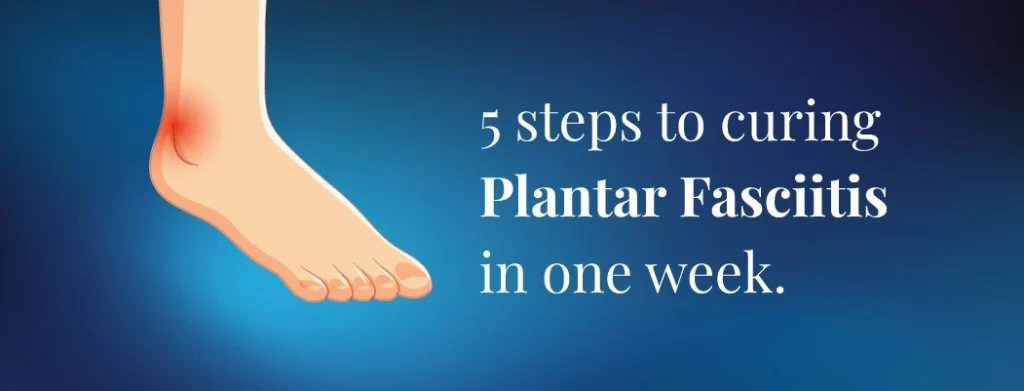
Plantar fasciitis: what is it?
Inflammation of the plantar fascia of the foot is known as plantar fasciitis. It is the most common reason for heel discomfort.
The plantar fascia, which connects the heel to the ball of the foot and toes, is a powerful fibrous attachment (like a ligament). It has the elasticity of a strong elastic band. The arch of the foot is formed by the plantar fascia, which also joins the bones of the foot together.
When the plantar fascia is overworked or overextended, plantar fasciitis develops. Your plantar fascia can enlarge as a result of any injury. Walking and using the foot becomes painful due to this inflammation. Plantar fasciitis usually affects one foot at a time, but it can also affect both feet at the same time.
See a doctor if you have foot or heel discomfort that persists for more than a week.
Cure plantar fasciitis
You have constant discomfort in your heel or ball of your foot if you have plantar fasciitis. This is because the tissue that connects the toes to the heel bone is affected by a degenerative disease, even though it may look like inflammation. People who run frequently, have flat feet or high arches, are overweight, or spend a lot of time on their feet are also more likely to develop plantar fasciitis.
It may take 6 to 12 months for your foot to return to normal. To reduce discomfort and speed up the healing process, you can do the following at home:
Rest: It is essential to avoid putting weight on the foot until the inflammation disappears.
Ice: There are several ways to use ice to relieve inflammation. It is a simple method. First, wrap a towel around a plastic bag filled with crushed ice or a container with frozen corn or peas to create an ice pack. Then place it on your heel 3 to 4 times a day for 15 to 20 minutes. Alternatively, put ice and water in a shallow saucepan and dip your heel in it many times a day for 10 to 15 minutes. Keep your feet out of the water at all times.
Exercise and stretching: Flex your Achilles tendon, calves, and soles of your feet. Do activities to strengthen the muscles in your feet and lower legs. This can stabilize your ankle, reduce your pain, and prevent plantar fasciitis from recurring.
Athletic tape: Wrapping your foot can support it and prevent you from moving it in a way that aggravates plantar fasciitis.
Shoe Insoles – These can also be called insoles, arch supports, or orthotics and can offer you more cushioning and support. Typically, your results will be just as good and less expensive with over-the-counter inserts. Firmer is preferable when selecting one; Make sure it has enough arch support.
Foot Heel Pads: The heel hits the ground with each stride, putting pressure on the plantar fascia. You may find the heel-shaped padding on your shoes helpful. They lift the heel to relieve pressure and provide more cushioning. They are an inexpensive alternative to try, even if they often don’t work as well as inserts.
Night splints: The plantar fascia and Achilles tendon shorten when most sleep with their feet pointing downward. Wearing night splints while you sleep maintains the 90-degree angle of your feet. So instead of shortening your plantar fascia while you sleep, you get a continuous, healthy stretch.
Foot Massage: Keep a golf ball, tennis ball, or Mobility Ball on your desk, in a desk drawer, or in your bag as a simple and effective massage tool that you can use throughout the day to comfort and relieve discomfort. Use the ball while sitting at your computer or take a short break while standing to roll the ball under your foot while applying constant pressure. Don’t avoid painful “hot spots.” Before rolling the ball, press steadily (without causing sudden or unbearable pain) on the painful area for a few seconds. The pressure from the massage blocks the brain’s pain receptors, increases blood flow to the arch and heel, and dissolves painful adhesions (tears that were improperly repaired) in the plantar fascia ligament. Place the ball in the freezer at the beginning of the day for extra relief and a soothing cold treatment.
More extensive research is needed to demonstrate the effectiveness of massage, but there is plenty of anecdotal evidence. Self-massage significantly reduces pain, according to several smaller studies, one of which was published in the Journal of Acupuncture and Meridian Studies.
Roll a water bottle around your feet: You probably have a water bottle on your nightstand, kitchen, or desk. You can use this simple treatment to combat plantar fasciitis effectively. Simply sit in a chair, roll a water bottle between your heel and toe 10 times, and then switch sides. This is similar to stretching the ball. Press constantly, but never until you feel pain. Freeze it beforehand for additional healing and relief!
The RICE method: resting the injured foot is essential when pain initially occurs. RICE is a common first aid procedure for foot injuries:
A: Give the painful area a few days of rest.
I: To reduce swelling, apply ice to the region for 20 minutes at a time.
C: Apply a soft bandage to the area to minimize swelling.
E: Place a few pillows under your foot to elevate the area.
Which doctor should I see if I have plantar fasciitis?
A podiatrist will be able to evaluate your foot type and suggest the appropriate footwear or advise you to prevent sources of discomfort. A tight calf muscle and fascia can be stretched to help release tension.

